| Pages:
1
2
3
..
9 |
Morgan
International Hazard
    
Posts: 1728
Registered: 28-12-2010
Member Is Offline
Mood: No Mood
|
|
Name that rock
I was looking at some old rocks and found this one with kind of a gray bubble surface on top and was just wondering what it might be. It's kind of
hard to make it out so I'm posting some other rock with kind of the same bubble appearance in quartz I guess.
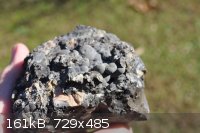
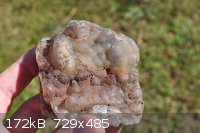
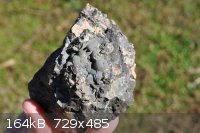
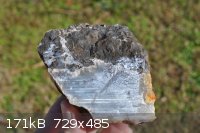
[Edited on 24-1-2014 by Morgan]
|
|
|
UnintentionalChaos
International Hazard
    
Posts: 1454
Registered: 9-12-2006
Location: Mars
Member Is Offline
Mood: Nucleophilic
|
|
That growth style is known as "botryoidal" The pinkish one, to my untrained eye might be smithsonite (ZnCO3). Might want to look into hematite and
malachite as well, which commonly form this structure.
[Edited on 1-23-14 by UnintentionalChaos]
Department of Redundancy Department - Now with paperwork!
'In organic synthesis, we call decomposition products "crap", however this is not a IUPAC approved nomenclature.' -Nicodem
|
|
|
phlogiston
International Hazard
    
Posts: 1381
Registered: 26-4-2008
Location: Neon Thorium Erbium Lanthanum Neodymium Sulphur
Member Is Offline
Mood: pyrophoric
|
|
A psilomelane?
Romanechite:
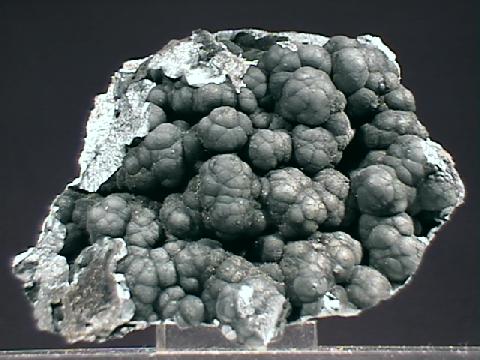
hollandite:

Where dit it come from?
-----
"If a rocket goes up, who cares where it comes down, that's not my concern said Wernher von Braun" - Tom Lehrer |
|
|
bfesser
Resident Wikipedian
    
Posts: 2114
Registered: 29-1-2008
Member Is Offline
Mood: No Mood
|
|
I'm fairly certain it's (first photo) not hematite or malachite. My best guess is botryoidal <a href="http://en.wikipedia.org/wiki/Fluorapatite"
target="_blank">fluorapatite</a> <img src="../scipics/_wiki.png" /> (New York?). It's difficult to identify any rock or mineral from
photos alone.
[edit] On re-examination of the photos; I wouldn't rule out hematite. See this topic for ideas on identification techniques: <strong><a
href="viewthread.php?tid=25943">Presence of traces iron oxide minerals in limestone</a></strong>
[Edited on 23.1.14 by bfesser]
|
|
|
Morgan
International Hazard
    
Posts: 1728
Registered: 28-12-2010
Member Is Offline
Mood: No Mood
|
|
Thanks for the replies. I guess the word I was looking for was
botryoidal. The rocks were some old mildly curious "outdoor" rocks my Dad had collected. He had about a wheel barrel full of them. They may have come
from Oregon, we used to live there.
I once visited the Smithsonian and looked at all of the mineral collection. Neat stuff those rocks. Universities too have some good displays.
|
|
|
IrC
International Hazard
    
Posts: 2710
Registered: 7-3-2005
Location: Eureka
Member Is Offline
Mood: Discovering
|
|
004.JPG looks very similar to poor quality common milky opal, Although I'm not a mineralogist and am unsure why in one rock some quartz would be so
hydrated compared to the substrate. Also has some similarity in appearance to Chalcedony except that would be unusual to be with typical quartz. No my
mind keeps going back to maybe an opal that had near zero trace impurities to add color when it was forming.
"Science is the belief in the ignorance of the experts" Richard Feynman
|
|
|
bfesser
Resident Wikipedian
    
Posts: 2114
Registered: 29-1-2008
Member Is Offline
Mood: No Mood
|
|
<strong>IrC</strong>, I agree that the second specimen does look a lot like <a href="http://en.wikipedia.org/wiki/Chalcedony"
target="_blank">chalcedony</a> <img src="../scipics/_wiki.png" />. In fact, after finishing my previous reply, I went through my
mineral cabinet drawers, and found a similar looking specimen of fluorescent chalcedony with calcite. I also found a specimen of botryoidal <a
href="http://en.wikipedia.org/wiki/Hematite" target="_blank">hematite</a> <img src="../scipics/_wiki.png" /> that looks similar to the
rock in the first photo—leading me to retract my first statement. I'll try to take some photos of my specimens tomorrow morning; if for no
other purpose than aesthetic gratification. For the hell of it, I'll try to take some <a
href="viewthread.php?tid=28664#photos">fluorescence/phosphorescence photos</a> tonight.
[Edited on 1.2.14 by bfesser]
|
|
|
Zephyr
Hazard to Others
  
Posts: 341
Registered: 30-8-2013
Location: Seattle, WA
Member Is Offline
|
|
My father is a geologist and has a large collection of rare rocks, can anyone guess what these are?




|
|
|
Tdep
National Hazard
   
Posts: 519
Registered: 31-1-2013
Location: Laser broken since Feb 2020 lol
Member Is Offline
Mood: PhD is done! It isn't good but it's over lol
|
|
The last one I believe is rhodonite
The first one may be gypsum which is pretty easy to tell from the softness of it (you can basically scratch it with a fingernail)
|
|
|
Zephyr
Hazard to Others
  
Posts: 341
Registered: 30-8-2013
Location: Seattle, WA
Member Is Offline
|
|
Yes, the first one is orange gypsum, found in North Africa. That one was the easiest though, the last one is not rhodonite.
|
|
|
Tdep
National Hazard
   
Posts: 519
Registered: 31-1-2013
Location: Laser broken since Feb 2020 lol
Member Is Offline
Mood: PhD is done! It isn't good but it's over lol
|
|
It's not rhodochrosite then? It doesn't look quite pink enough to be but it's worth a guess...
|
|
|
phlogiston
International Hazard
    
Posts: 1381
Registered: 26-4-2008
Location: Neon Thorium Erbium Lanthanum Neodymium Sulphur
Member Is Offline
Mood: pyrophoric
|
|
Then fluorite perhaps? I once found some fluorite that looks similar.
[Edited on 24-1-2014 by phlogiston]
-----
"If a rocket goes up, who cares where it comes down, that's not my concern said Wernher von Braun" - Tom Lehrer |
|
|
bfesser
Resident Wikipedian
    
Posts: 2114
Registered: 29-1-2008
Member Is Offline
Mood: No Mood
|
|
Morgan, try a streak test on your unknown botryoidal mineral. All you need is a piece of unglazed porcelain—sometimes the
back of a tile is suitable. If the <a href="http://flic.kr/p/jCquG6" target="_blank">streak is brick red</a> <img
src="../scipics/_ext.png" />, it's likely hematite. Pinkhippo11, you can't seriously expect us to identify those based on some poor quality low-resolution photos
alone. Regardless, I'll take a stab at the second and fourth; are they pumice and <a href="http://www.mindat.org/min-972.html"
target="_blank">charoite</a> <img src="../scipics/_ext.png" />? (By the way, <a href="http://en.wikipedia.org/wiki/Gypsum"
target="_blank">gypsum</a> <img src="../scipics/_wiki.png" /> is a mineral, not a rock.)
<hr width="80%" />
<a id="photos"></a>Here are the photos I promised—labeled, because I don't like guessing games:
<table><tr><td><a href="http://www.flickr.com/photos/35937732@N02/12112705226/" title="Chalcedony & Calcite by bfesser,
on Flickr" target="_blank"><img src="http://farm3.staticflickr.com/2880/12112705226_b1d52b9b84_m.jpg" width="240" height="180" alt="Chalcedony
& Calcite"></a></td><td><a href="http://www.flickr.com/photos/35937732@N02/12112047055/" title="Chalcedony &
Calcite Fluorescence by bfesser, on Flickr" target="_blank"><img src="http://farm6.staticflickr.com/5524/12112047055_22cd41ff53_m.jpg"
width="240" height="180" alt="Chalcedony & Calcite Fluorescence"></a></td></tr><tr><td
align="center">Chalcedony & Calcite</td><td align="center">254 nm Fluorescence</td></tr></table>
<table><tr><td><a href="http://www.flickr.com/photos/35937732@N02/12112812626/" title="Opal by bfesser, on Flickr"
target="_blank"><img src="http://farm3.staticflickr.com/2888/12112812626_ae80bf9e1b_m.jpg" width="240" height="180"
alt="Opal"></a></td><td><a href="http://www.flickr.com/photos/35937732@N02/12112457473/" title="Opal Fluorescence by bfesser,
on Flickr" target="_blank"><img src="http://farm8.staticflickr.com/7310/12112457473_8b768f03e3_m.jpg" width="240" height="180" alt="Opal
Fluorescence"></a></td></tr><tr><td align="center">Dendritic Opal</td><td align="center">254 nm
Fluorescence</td></tr></table>
<table><tr><td><a href="http://www.flickr.com/photos/35937732@N02/12112209865/" title="Opal by bfesser, on Flickr"
target="_blank"><img src="http://farm8.staticflickr.com/7302/12112209865_86d7af366a_m.jpg" width="240" height="180"
alt="Opal"></a></td><td><a href="http://www.flickr.com/photos/35937732@N02/12112888746/" title="Hematite, botryoidal by
bfesser, on Flickr" target="_blank"><img src="http://farm6.staticflickr.com/5472/12112888746_7b27b3c74c_m.jpg" width="240" height="180"
alt="Hematite, botryoidal"></a></td></tr><tr><td align="center">Dendritic Opal</td><td
align="center">Botryoidal Hematite</td></tr></table>
While I had the UV lamp and camera out:
<table><tr><td><a href="http://www.flickr.com/photos/35937732@N02/12112657796/" title="Zircon by bfesser, on Flickr"
target="_blank"><img src="http://farm6.staticflickr.com/5520/12112657796_e041cc1709_m.jpg" width="240" height="180"
alt="Zircon"></a></td><td><a href="http://www.flickr.com/photos/35937732@N02/12112296573/" title="Zircon Fluorescence by
bfesser, on Flickr" target="_blank"><img src="http://farm3.staticflickr.com/2817/12112296573_ebe75d1b99_m.jpg" width="240" height="180"
alt="Zircon Fluorescence"></a></td></tr><tr><td align="center">Zircon</td><td align="center">254 nm
Fluorescence</td></tr></table>
<table><tr><td><a href="http://www.flickr.com/photos/35937732@N02/12112370263/" title="Calcite/Dolostone by bfesser, on Flickr"
target="_blank"><img src="http://farm4.staticflickr.com/3695/12112370263_2b5a7acfa1_m.jpg" width="240" height="180"
alt="Calcite/Dolostone"></a></td><td><a href="http://www.flickr.com/photos/35937732@N02/12112460364/" title="Calcite/Dolostone
Fluorescence by bfesser, on Flickr" target="_blank"><img src="http://farm4.staticflickr.com/3712/12112460364_d5191f04f3_m.jpg" width="240"
height="180" alt="Calcite/Dolostone Fluorescence"></a></td></tr><tr><td align="center">Dolostone &
Calcite</td><td align="center">254 nm Fluorescence</td></tr></table>
<table><tr><td><a href="http://www.flickr.com/photos/35937732@N02/12112410943/" title="Calcite by bfesser, on Flickr"
target="_blank"><img src="http://farm6.staticflickr.com/5499/12112410943_024587a17c_m.jpg" width="240" height="180"
alt="Calcite"></a></td><td><a href="http://www.flickr.com/photos/35937732@N02/12112406893/" title="Calcite Fluorescence by
bfesser, on Flickr" target="_blank"><img src="http://farm6.staticflickr.com/5533/12112406893_1ea7e30233_m.jpg" width="240" height="180"
alt="Calcite Fluorescence"></a></td><td><a href="http://www.flickr.com/photos/35937732@N02/12112106525/" title="Calcite
Phosphorescence by bfesser, on Flickr" target="_blank"><img src="http://farm4.staticflickr.com/3746/12112106525_c56a839996_m.jpg" width="240"
height="180" alt="Calcite Phosphorescence"></a></td></tr><tr><td align="center">Calcite</td><td
align="center">254 nm Fluorescence</td><td align="center">Phosphorescence</td></tr></table>
My favorites:<table><tr><td><a href="http://www.flickr.com/photos/35937732@N02/12112512574/" title="Calcite Vug Fluorescence by
bfesser, on Flickr" target="_blank"><img src="http://farm4.staticflickr.com/3717/12112512574_affa55cb26_m.jpg" width="240" height="180"
alt="Calcite Vug Fluorescence"></a></td><td><a href="http://www.flickr.com/photos/35937732@N02/12112772296/" title="Calcite
Vug Phosphorescence by bfesser, on Flickr" target="_blank"><img src="http://farm6.staticflickr.com/5540/12112772296_97bfdd9e16_m.jpg"
width="240" height="180" alt="Calcite Vug Phosphorescence"></a></td></tr><tr><td align="center"><a
href="viewthread.php?tid=14644&page=40#pid297682">Calcite</a> 254 nm Fluorescence</td><td
align="center">Phosphorescence</td></tr></table>
[Edited on 1.2.14 by bfesser]
|
|
|
Random
International Hazard
    
Posts: 1120
Registered: 7-5-2010
Location: In ur closet
Member Is Offline
Mood: Energetic
|
|
Guys how do you identify rocks? Is there some kind of protocol for that? I never understood how one could do it so easily if there are so many similar
ones and each rock actually looks even more similar to my untrained eye.
|
|
|
violet sin
International Hazard
    
Posts: 1483
Registered: 2-9-2012
Location: Daydreaming of uraninite...
Member Is Offline
Mood: Good
|
|
morgan:
#2 looks like hyalite opal
pinkhippo11:
#2 looks to be small grain lepidolite, but too blurry to tell. I have a single crystal 2" and a few pieces of small grain like packed lilac colored
glitter
#3 maybe barite?
bfesser: nice pics, love the zircon
I have some mineral specimens to add here, just edit them in this post here in a bit. botryoidal hyalite opal, botryoidal jade, bot- fire agate to
start with
|
|
|
blargish
Hazard to Others
  
Posts: 166
Registered: 25-9-2013
Location: Canada
Member Is Offline
Mood: Mode Push
|
|
On the topic of botryoidal formations, here are a couple from my collection.
Hemimorphite (blue), Malachite/Azurite (green/royal blue)
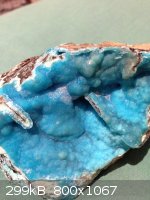 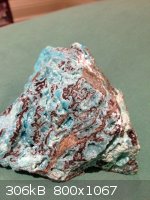 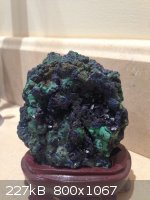
|
|
|
Zephyr
Hazard to Others
  
Posts: 341
Registered: 30-8-2013
Location: Seattle, WA
Member Is Offline
|
|
Alright, the pictures were a bit blurry so I'll just tell you what the rocks were.
In order from first to last:
-Gypsum.
-Tremolite, manganese gives it its color.
-Dolomite Crystal, these have rare curved faces.
-Fuchsite, a chromium rich green mica, the pink is quarts.
|
|
|
violet sin
International Hazard
    
Posts: 1483
Registered: 2-9-2012
Location: Daydreaming of uraninite...
Member Is Offline
Mood: Good
|
|
hyalite opal .......................................fire agate
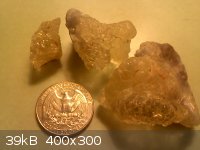 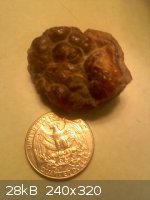
jade................................................... lepidolite in front of a lamp
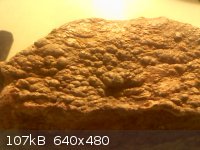 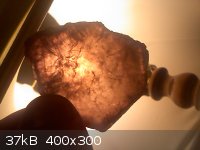
the hyalite opal flouresces but the camera I was using sucks, so it didn't show any of the color. UV won out  it is about 1/10th the brightness of uranium glass I have( good stuff, quite bright) it is about 1/10th the brightness of uranium glass I have( good stuff, quite bright)
|
|
|
BromicAcid
International Hazard
    
Posts: 3266
Registered: 13-7-2003
Location: Wisconsin
Member Is Offline
Mood: Rock n' Roll
|
|
Quote: Originally posted by Random  | | Guys how do you identify rocks? Is there some kind of protocol for that? I never understood how one could do it so easily if there are so many similar
ones and each rock actually looks even more similar to my untrained eye. |
From my limited training there is more to it than just looking at the rock. For example, look at the wiki article on zircon. Look at all the information listed under identification. Streak test is pretty common (mentioned above) but when you are out in the
field you use what is obvious (color, crystal structure) to narrow it down then you start to examine other features such as cleavage, hardness, etc.
to peg it to a specific mineral. I don't think there is any sort of master chart with all the different rocks/minerals on it where you can start from
the top and work your way down. Afterall, there are soooooo many minerals out there, some only found in one or two places in the world or only found
once for a single sample. It's interesting but it's a huge field in itself. Then again I am sure a lot of geologist nowadays just send out the rock
for elemental analysis though they might have a general idea of what it is beforehand.
|
|
|
bfesser
Resident Wikipedian
    
Posts: 2114
Registered: 29-1-2008
Member Is Offline
Mood: No Mood
|
|
As of 10/2013, there were 4859 <a href="http://www.ima-mineralogy.org/" target="_blank">International Mineralogical Association (IMA)</a>
<img src="../scipics/_ext.png" /> listed mineral species. This isn't for identification, but it's a 'master chart'.
Attachment: IMA_Master_List_(2013-10).pdf (1.5MB)
This file has been downloaded 1836 times
|
|
|
Morgan
International Hazard
    
Posts: 1728
Registered: 28-12-2010
Member Is Offline
Mood: No Mood
|
|
This rock looks like it fractured, shifted, and then cemented itself back together. I don't know what formed it that way or what it's called. Or maybe
it grew and crowded into this arrangement?
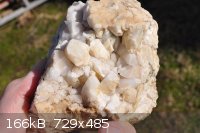 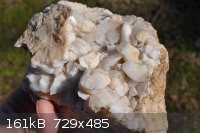
[Edited on 26-1-2014 by Morgan]
|
|
|
Morgan
International Hazard
    
Posts: 1728
Registered: 28-12-2010
Member Is Offline
Mood: No Mood
|
|
This is some crumbly rock I have no idea about.
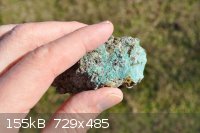 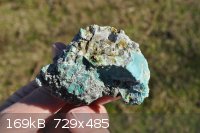 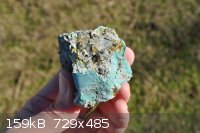
|
|
|
elementcollector1
International Hazard
    
Posts: 2689
Registered: 28-12-2011
Location: The Known Universe
Member Is Offline
Mood: Molten
|
|
Looks like paint on the outside to me...
Elements Collected:52/87
Latest Acquired: Cl
Next in Line: Nd
|
|
|
Morgan
International Hazard
    
Posts: 1728
Registered: 28-12-2010
Member Is Offline
Mood: No Mood
|
|
More of my inherited outdoor rocks, I made a sharp flat shard in a shiny solid black obsidian that fits in the palm of my hand. The very thin cutting
edge is translucent brown if held up to the light while the rest opaque glassy black. I just took a hunk and hit it with a hammer. It's neat how you
can fit the strange smooth surfaces back together if you split one in half.
I like these other obsidian pieces better though, the few pinkish speckles here and there might be pretty if the piece were split open. The other kind
of reminds me of a wood grain.
I find the shapes of rocks almost as interesting as what they are made of sometimes.
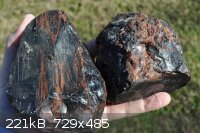 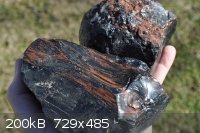 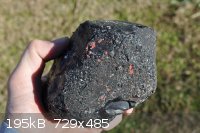 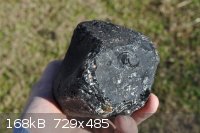
|
|
|
Morgan
International Hazard
    
Posts: 1728
Registered: 28-12-2010
Member Is Offline
Mood: No Mood
|
|
Now that you mention it, it does look like it could be some man-made paint or plastic bits that were cemented with sediments. There's also some
yellow-green algae growing on it too.
|
|
|
| Pages:
1
2
3
..
9 |